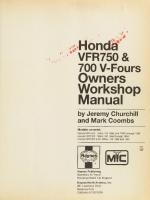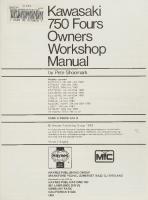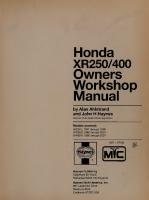Haynes Honda CBR600F2 Fours Owners Workshop Manual [2070] 1563920700, 9781563920707
“Haynes disassembles every subject vehicle and documents every step with thorough instructions and clear photos. Haynes
118 84 29MB
English Pages 228 Year 1994
Recommend Papers
File loading please wait...
Citation preview
CBR600F2 Fours F-M, F-N, F-P & F-R models)
1991 to 1994 0 599cc
Digitized by the Internet Archive In 2022 with funding from Kahle/Austin Foundation
httos://archive.org/details/nondacbr600f2own0000coom
by Mark Coombs Member of the Guild of Motoring Writers
Models covered:
Honda CBR600F2 (F-M, F-N, F-P, F-R). 599cc. 1991 through 1994 Note: The 598cc CBR600F (F-H, F-J, F-K and F-L) models 1987 through 1991 are covered in OWM No. 1730 ABCDE FGHIJ KLMNO PQRST
Haynes Publishing Sparkford Nr Yeovil Somerset BA22 7JJ England Haynes North America, Inc 861 Lawrence Drive Newbury Park
01564550 - ITEM
HHUMA
California 91320 USA
Te
oe
COUNTY Ta se lien
Acknowledgements Our thanks are due to Paul Branson Motorcycles of Yeovil who supplied the CBR600F2 featured in the illustrations throughout this manual. We would also like to thank NGK Spark Plugs (UK) Ltd for supplying the color spark plug condition photos and the Avon Rubber Company for supplying information on tire fitting.
© Haynes North America, Inc.
1994
With permission from J.H. Haynes & Co. Ltd.
A book in the Haynes Owners Workshop Manual Series Printed in the U.S.A. All rights reserved. No part of this book may be reproduced or transmitted in any form or by any means, electronic or mechanical, including photocopying, recording or by any information storage or retrieval system, without permission in writing from the copyright holder.
ISBN 1 56392 070 0 Library of Congress Catalog Card Number 94-77759 British Library Cataloguing in Publication Data
A catalogue record for this book is available from the British Library We take great pride in the accuracy of information given in this manual, but motorcycle manufacturers make alterations and design changes during the production run of a particular motorcycle of which they do not inform us. No liability can be accepted by the authors or publishers for loss, damage or injury caused by any errors in, or omissions from, the information given. 94-224
e
Contents Introductory pages About this manual Introduction to the Honda CBR600F2 Identification numbers Buying parts General specifications Maintenance techniques, tools and working facilities Safety first! Motorcycle chemicals and lubricants Troubleshooting
0-5 0-5 0-6 0-7 0-7 0-8 0-14 0-15 0-16
Chapter 1 Tune-up and routine maintenance
1-1
Chapter 2 Engine, clutch and transmission
2-1
Chapter 3 Cooling system
3-1
Chapter 4 Fuel and exhaust systems
4-1
Chapter 5 Ignition system
5-1
Chapter 6 Frame, suspension and final drive
6-1
Chapter 7 Brakes, wheels and tires
7-1
Chapter 8 Fairing and bodywork
8-1
Chapter 9 Electrical system
Wiring diagrams
9-1
9-23
Conversion factors Index
IND-1
Right front view of the 1991 Honda CBR600F2
Right side view of the 1993 Honda CBR600F2
About this manual Its purpose The purpose of this manual is to help you get the best value from your motorcycle. It can do so in several ways. It can help you decide
At the beginning of each numbered Section you will be referred to any illustrations which apply to the procedures in that Section. The reference numbers used in illustration captions pinpoint the pertinent
if you choose to have it done bya
Section and the Step within that Section. That is, illustration 3.2 means
dealer service department or a repair shop; it provides information and
the illustration refers to Section 3 and Step (or paragraph) 2: within that Section. Procedures, once described in the text, are not normally repeated. When it’s necessary to refer to another Chapter, the reference will be given as Chapter and Section number. Cross references given without use of the word ‘Chapter’ apply to Sections and/or paragraphs in the same Chapter. For example, see Section 8’ means in the same Chapter. References to the left or right side of the vehicle assume you are sitting on the seat, facing forward. Motorcycle manufacturers continually make changes to specifi-
what work must be done, even
procedures for routine maintenance and servicing; and it offers diag-
nostic and repair procedures to follow when trouble occurs. We hope you use the manual to tackle the work yourself. For many simpler jobs, doing it yourself may be quicker than arranging an appointment to get the vehicle into a shop and making the trips to leave it and pick it up. More importantly, a lot of money can be saved by avoiding the expense the shop must pass on to you to cover its labor and overhead costs. An added benefit is the sense of satisfaction and accomplishment that you feel after doing the job yourself.
Using the manual The manual is divided into Chapters. Each Chapter is divided into numbered Sections, which are headed in bold type between horizontal lines. Each Section consists of consecutively numbered paragraphs or steps.
cations and recommendations,
and these, when notified, are incorpo-
rated into our manuals at the earliest opportunity. Even though we have prepared this manual with extreme care, neither the publisher nor the author can accept responsibility for any errors in, or omissions from, the information given.
NOTE A Note provides information necessary to properly complete a procedure or information which will make the procedure easier to understand.
CAUTION A Caution provides a special procedure or special steps which must be taken while completing the procedure where the Caution is found. Not heeding a Caution can result in damage to the assembly being worked on.
WARNING A Warning provides a special procedure or special steps which must be taken while completing the procedure where the Warning is found. Not heeding a Warning can result in personal injury.
Introduction to the Honda CBR600F2 The Honda CBR600F2 is a high-performance sport motorcycle. It supersedes the 1987 through 1991 CBR600F (or F1), produced under
the model codes F-H, F-J, F-K and F-L. The engine is a liquid-cooled, inline four with double overhead
camshafts and four valves per cylinder. The design has remained essentially the same since its introduction in 1991, with a change of front and rear suspension being the only significant modification. Fuel is delivered through four Keihin CV 34 mm carburetors. The front suspension on early models features front fork spring preload adjustment. On later models both front fork spring preload
and fork damping are adjustable. The rear suspension uses the Honda Pro-Link design, which employs a shock absorber/spring unit mounted ahead of the swingarm. The suspension provides a progressive damping effect. On early models, spring preload and shock absorber rebound damping are adjustable. On later models, the spring preload Is adjustable as are both shock absorber rebound and compression damping. The front brakes use dual discs and the rear brakes use a single disc.
0-6
identification numbers
Model code is printed on the color code label located behind the right side cover
The frame serial number is stamped into the right side of the steering head. The engine number is stamped into the right upper side of the crankcase, directly above the clutch unit. Both of these numbers should be recorded and kept in a safe place so they can be furnished to law enforcement officials in the event of a theft. The frame serial number, engine serial number and carburetor
identification number should also be kept in a handy place (such as with your driver’s license) so they are always available when purchasing or ordering parts for your machine.
Identifying model years The procedures in this manual identify the bikes by model code. The model code (e.g. CBR600FM) is printed on the color code label, which is stuck on the right side of the frame, behind the right side cover. The model code and production year can also be determined from the engine and frame serial numbers as follows: Engine number is stamped on the right side of the crankcase
UK models CE REOO RANT (AGOM eecstuvohwia niet tcass cians CBRGOOR-NH092) iene titayeiviniecneenvins CBERGOGE-Pi (1996) Esc ee ince een os CBERGOOFRi1G04) 2). see eat tea
Engine number PC25E-2000105 to 2020536 ......cccccescesescescsseseseeseens PG25E-2 10319710 2027-4 40h oe certs PO25R
a BOLT — MOUNTING PLATE 4
i
REAR VIEW MIRROR
Z
UPPER FAIRING ASSEMBLY
SCREW
2.12
Upper fairing assembly and associated components
2070-8-2.12 HAYNES
8-4
2.15
Chapter 8
Fairing and bodywork
2.16 ... then disconnect the wiring plug from the headlight bulb and remove the upper fairing
Disconnect the turn signal and sidelight (UK models only) wiring at the wiring connectors...
13 Remove the windshield as described in Section 3. 14 Undo the two upper fairing assembly retaining screws (one on either side) and move the upper fairing assembly forward until access can be gained to the wiring connectors located in front of the instrument cluster (see illustrations). 15 Support the fairing then trace the wiring back from each turn signal assembly and the sidelight (UK models only) and disconnect the three wiring connectors (see illustration). 16 Disconnect the wiring plug from the rear of the headlight unit and remove the upper fairing from the motorcycle (see illustration). Examine the fairing mounting dampers for signs of damage and replace if necessary.
3
Windshield - removal and installation
Removal Refer to illustration 3.2 1 Remove both rear view mirrors as described in Section 4. 2 Carefully lift the windshield away from the upper fairing assembly and recover the mounting damper from each side of the fairing mounting stay (see illustration).
Installation $3
Installation is the reverse of removal.
4
Rear view mirrors - removal and installation
Installation Lower fairing panels 17 Installation is the reverse of removal ensuring the lower fairing panels are correctly hooked together and secured in position by all the relevant screws and fasteners.
Upper fairing assembly 18 Installation is the reverse of removal ensuring the pegs on the headlight are correctly aligned with dampers on the fairing stay. On completion check the headlight aim as described in Chapter 9.
Removal Refer to illustrations 4.1a, 4.1b,'4.2a, 4.2b and 4.2c
1 Undo the screw and remove the rear view mirror trim panel from inside the upper fairing (see illustrations). 2 Peel back the rubber cover then undo the two retaining bolts and remove the rear view mirror along with its mounting plate and damper (see illustrations).
Chapter 8
Fairing and bodywork
3.2 With the windshield removed recover the mounting damper (arrow) from each side of the fairing stay
64
ne/A
ayuYa ree
LH9IT
91 1H9I7 ama
=O
=~8
os
LINN) Ags
‘NOU
Na3u9
3ONBYO
NAOWS
aed
A
«1a
SHIM pens
AOTISA
yous
SHO109
9
9-24 Electrical system
G/B
=>
:
-
‘
i
, at
| 1
|
-
i
|
sg oer
we
—
4
a
ta
=
— 7
in
‘
7
-
b
o> * «Ab = ~~
é
:4
i)
—-
iw
-
ogee
= -
Pep
——
> rv
Ae = ete
ae a
a.
— ae










![Haynes Honda CBR600F2 Fours Owners Workshop Manual [2070]
1563920700, 9781563920707](https://ebin.pub/img/200x200/haynes-honda-cbr600f2-fours-owners-workshop-manual-2070-1563920700-9781563920707.jpg)